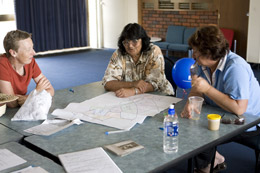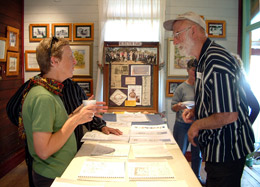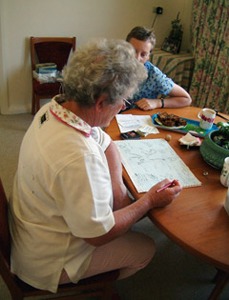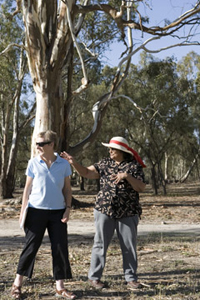Selecting locations and people
Why Lightning Ridge and Robinvale?
Lightning Ridge and Robinvale were selected as the locations of the research because they had distinct and rich migration histories. The population in each locality includes people from over forty different countries – a significant diversity in populations of around 7- 8,0000 (see local migration histories).
They were also selected because the relevant community organisations in Lighting Ridge and Robinvale were enthusiastic about hosting the research and felt that their communities would benefit from being participants. The idea of a two-way process between Migration Memories and those involved was central to the research.
The importance of support from community organisations
Community organisations were the project’s guides to history, place and people. They provided background information and contacts with potential participants. They provided office space and equipment and provided or helped secure exhibition venues. They organised meetings and activities to support the research and they were the main organisers of the exhibition launches and publicity.
 |
 |
|
| ‘Show and tell’ event to share migration objects organised by Robinvale Network House as part of the Robinvale Multicultural Festival. Photograph: Jo Sheldrick, 2006. | Meeting to discuss exhibition designs at Lightning Ridge Historical Society Gallery. Photograph: Jenni Brammall, 2006. |
In Lightning Ridge the support organisations were the Lightning Ridge Historical Society and the Lightning Ridge and Region Transcultural Community Council. The Australian Opal Centre also played an important support role and Opal FM radio station hosted a recording session for the Lightning Ridge sound installation.
In Robinvale the organisations were Robinvale Network House, Euston-Robinvale Historical Society and Regional Arts Victoria. The Robinvale Secondary College, the Robinvale Sentinel, Swan Hill Rural City Council and the Swan Hill Regional Art Gallery also supported the research’s activities.
A simple form of Memorandum of Understanding concerning the research and the contribution of the main support organisations was drawn up at the beginning of the research process. The project provided a modest honorarium in consideration of the support provided.
Selecting the ‘story teller’ participants
The first stage in selecting individual participants was to identify key periods and types of migration to the particular locality. The second stage was to find an individual with a story that connected with each significant migration. It was important for potential participants to be happy to develop their story for public display – and to work closely with the researcher/curator over the better part of a year.
 |
 |
|
| Jennifer Colless working with Mary Hutchison for Migration Memories: Lightning Ridge. Photograph: Jenni Brammall 2005. |
Rose Kirby working with Mary Hutchison for Migration Memories: Robinvale. Photograph: Jo Sheldrick, 2007. |
The community organisations in each place played an important role in the selection process. They suggested people known to them who might be prepared to participate and who might also feel that they would get something out of the process for themselves. The process of ‘selecting’ was generally one of ‘finding’ people who were interested and had enough spare time.
